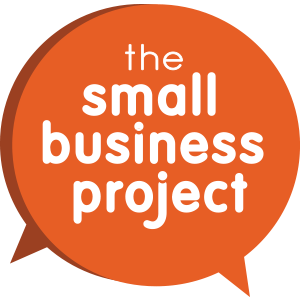
A Boost for The UK’s AI Sector
The Government this week have been announcing details of their new Digital Strategy which aims to boost the digital economy and help to plug the digital skills gap. Artificial Intelligence is set to add £654 billion to the UK economy by 2035 so it’s no wonder the AI sector plays a key role in the strategy.
Business Secretary Greg Clark said, “Innovation is at the heart of our Industrial Strategy and the launch of the Government’s Digital Strategy underlines our commitment to this vital sector. By supporting British businesses and investing in dynamic fields such as robotics and AI, we will help put the UK at the forefront of global innovation.”
The Digital Strategy’s proposals are expected to include:
- A major AI review led by Wendy Hall and Jérôme Pesenti to identify the critical elements for the exciting technology to thrive and grow in the UK. It will consider how Government and industry could work together to back this technology, which could inform a sector deal. The UK is already a world-leader in the science underpinning this technology and the sector has the potential to grow further, from early research to commercialisation.
- Government is also expected to confirm a funding boost of £17.3m from the Engineering and Physical Sciences Research Council (EPSRC) to support the development of new Robotics and Artificial Intelligence (RAI) technologies in universities across the UK.
Some of the world’s most innovative AI companies are already based here in the UK, putting us in a great position to become a world leader in this fast moving and competitive sector. AI is increasingly creeping into our everyday lives, and helping all sorts of people with all kinds of things, including voice recognition on smartphones and the likes of Google Home, driverless cars, data insights...Continue reading

What We’ve Learned From The Tech Nation Report
The 2017 Tech Nation report was released last week by Tech City announcing the UK as the tech capital of Europe. The report discusses key findings relating to investment, talent, collaboration, growth, jobs and productivity.
The Prime Minister Theresa May introduced the report by saying; “Today more than 1.5 million people are already working within the digital sector, or in digital tech roles across other sectors, while the number of digital tech jobs across the UK has grown at more than twice the rate of non-digital tech sectors. From analysts to web developers to software architects, these pioneers of our digital economy are at the forefront of a great British success story.”
There are some interesting, insightful and encouraging findings, so we’ve picked out some of the highlights.
1) DIGITAL TECH INVESTMENT: In 2016 UK digital tech investment reached £6.8billion, that’s 50% higher than any other European country

2) DIGITAL TECH TALENT: The UK is home to 8 of Europe’s top 20 universities, more than any other European country

3) DIGITAL TECH COLLABORATION: London hosted 22,000 Meetups in 2016, that’s three times as many as in Berlin, Amsterdam or Paris

4) DIGITAL BUSINESS GROWTH: The turnover of digital tech businesses reached £170 billion, an increase of £30billion in just five years
 Continue reading
Continue reading
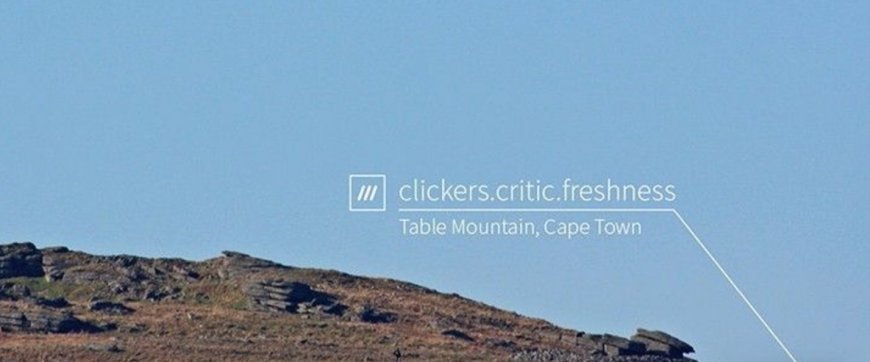
Making An Innovative Idea Global
Offering a solution to a problem is often where a start-up idea begins. To become a disruptor or offer a product or service that’s truly unique the idea has to be fresh, innovative and well-considered. In this article we’re going to take a quick look at an excellent example of a start-up that is disrupting on a global scale.
A Truly Disruptive Idea
What3words began when Chris Sheldrick travelled the world touring as a classical musician. He discovered that there are many areas across the world without an official address system. Home locations would be described along the lines of “past the hairdresser, four houses down on the left, between the pump and the bush” leaving visitors, deliveries and even firefighters struggling to reach their destination. For those who have travelled to areas of the world where this is an issue, such as sub-Saharan Africa, Mongolia, Costa Rica and the favelas of Brazil, you may understand why this is such an issue. Those who haven’t, you may never have even realised this was a problem that existed.
What what3words does is assign a three-word combination, like “table fork spoon,” to every three-meter square across the globe. There is no time and resource wasted trying to pinpoint exact locations of homes and doors, or any complicated latitude and longitude coordinates. This provides any and every area of the globe an ‘address.’
Consumers can use the what3words app for free for navigation, but their developer software is licenced out as a revenue stream. Courier services in Brazil are using what3words to bring e-commerce to the favelas for example. The start-up has also partnered with a number of humanitarian agencies across the world, such as Diaconia, a microfinance subsidiary of Norwegian NGO Mission Alliance. People living in Liberia without...Continue reading

Why Corporate Social Responsibility Makes Sense For SMEs
Corporate social responsibility is generally something we relate to large businesses employing hundreds of people, after all these organisations have more of an impact on society. However, growing SMEs may still employ staff, deal with freelancers, clients, partners and the wider community. Any business’ activity will in some way affect the environment, the economy and society.
As any business grows, so will its footprint, and it’s corporate social responsibility that will determine whether that footprint is positive or negative. You’ll often find a company’s values will display the responsibilities most important to them, such as a commitment to being green, or giving back to the environment. Investing in staff gives them the opportunity to grow and develop, and even engage themselves in corporate social responsibility. Smaller, day-to-day to day changes are easily made such as stocking fair-trade tea and coffee in the kitchen, or using other eco-friendly products where possible.
Giles Fuchs, Co-Founder of Office Space in Town explains, “a considered SME corporate social responsibility policy is key for any ambitious business hoping to grow and can no longer be an afterthought. A business’ commitment to corporate social responsibility is now a benchmark by which to measure its appeal – younger workers have ranked corporate social responsibility as a key criterion of an employer, clients increasingly consider it as of equal value as cost and investors more and more want assurances that their investments are socially responsible.”
As part of Office Space in Town’s CSR they encourage staff to get involved in community work, and they can take time out of work to do so. Giving purpose to a role, particularly for Millennials is increasingly important, as Simon Sinek explains in his popular video asking ‘the millennial question.’
Involving your SME in CSR can be on a large...Continue reading

What Design Trends Should We Be Looking Out For This Year?
For small businesses it’s vital to keep ahead of the crowd and be up to date with design trends and new ideas that could help you innovate or reach new customers. The Drum recently spoke to a number of experts to discover their thoughts on the hottest design trends to watch out for this year. They’re talking VUIs, empathy, the speed of living, and old fashioned ‘good ideas!’
Hana Tanimura, senior designer, Google Creative Lab
Traditionally, design has been synonymous with some kind of visual output. But that is changing quickly, and I believe that designing ‘invisible’ interactions will become increasingly important in the future.
Voice user interfaces (VUIs) haven’t always been successful at creating genuinely useful experiences for people. But machine learning has advanced by leaps and bounds in recent months, which has in turn enabled huge improvements in the field of natural language processing. These technological developments have fueled a rapid evolution in VUI design, and we’re beginning to see designers grapple with the possibilities that a hands-free, eyes-free interface can offer. (While voice interactions aren’t appropriate for all situations, I believe they will become more and more commonplace as we continue to expect technology to work for and around us in a more seamless way).
Alan Dye, co-founder and creative director NB Studio
Michael Wolff, a good friend of NB and a collaborator on many projects, introduced Nick [Finney, co-founder] and I recently to this wonderful quote by Maya Angelou.
“I’ve learned that people will forget what you said, people will forget what you did, but people will never forget how you made them feel”.
I believe that creating work that makes people feel something is what branding is all about. And it’s what NB have been doing for the past 20 years. Being...Continue reading

Only 9% Of Small Businesses Focus On Website Conversion
The Digital Marketing Magazine recently reported on some research by marketing agency Digimax. The research asked small businesses about their discussions with web designers while working on creating their new website. Here are some of the key findings:
- 9% of the time spent in discussions focuses on website conversion
- 3% of time is given to branding
- 27% of discussion time was spent on layout
- 23% on graphics and pictures
- Content takes up 38% of the time
Obviously, as a small business you want your website to looks great. You want it to be attractive and appealing, as in many cases it will be the gateway for new customers and new business. Content was given the most time for discussion and this, of course, is what keeps your users engaged – but then what? 98% of the businesses questioned actually said that they are building a website to make more money. So surely encouraging users to buy, or at least make an action, is the next (very important) step, once they have been impressed by a beautiful looking site and consumed all of your engaging content. So if you’re having a new website created, or you’re considering a re-design here are some tips to help turn your visitors into customers by considering your website conversion.
Website Conversion – What To Consider
Calls To Action – it needs to be clear and easy for your user to do what you want them to do. Whether that’s to make an enquiry, sign-up or buy something. If your CTA is hard to find, unclear or involves to0 many clicks or slow loading pages you risk losing potential customers.

Usability & Navigation – does your menu structure make...Continue reading

More Women in Tech Could Mean a Big Boost for European GDP
Across the EU there is a lack of women in tech and ICT roles. In fact, women make up only 18% of the ICT industry in Europe, compared to 48% in non-ICT sectors. This map, very interestingly, shows the percentage of women in tech across Europe. The UK come in at a below average 17%. Bulgaria, followed by Estonia and Romania come in top and Luxembourg has the lowest percentage of women in tech at 11%.
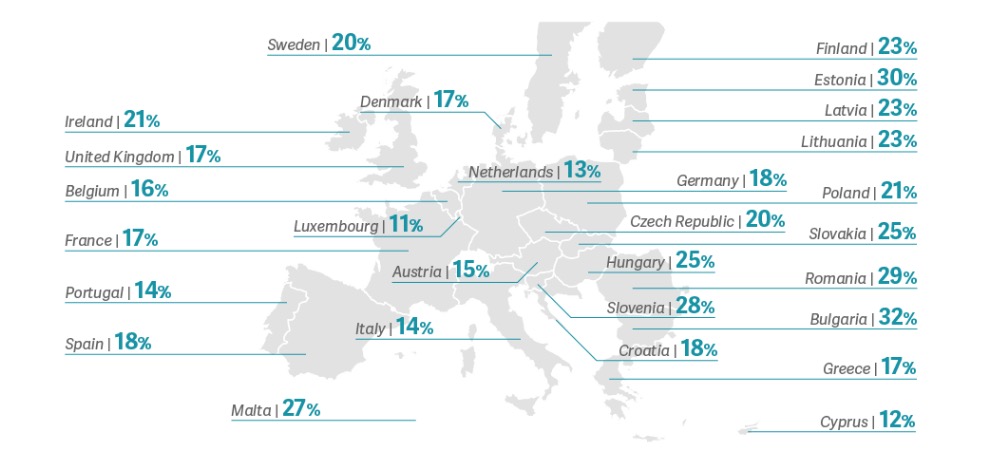
This issue may stem from the fact that women are much less likely to choose to study a technology or ICT related course at university. The figures show that out of 1000 women in Europe with BA degrees, only 29 of them studied in the tech field. It’s also true that women who do go on to work in this sector are less likely to hold high-level positions and become managers.

This all may sound rather negative, however women are paid more fairly in the tech sector. So this may not only encourage more women into the sector, but may help towards closing the gender pay gap which we still hear so much about in the UK. There is also a huge skills gap across the EU, with an estimated gap of 800,000 jobs requiring specialist ICT skills. Taking all this into account the European Commission has stated that European GDP could be boosted by 9 billion Euros a year if more women...Continue reading
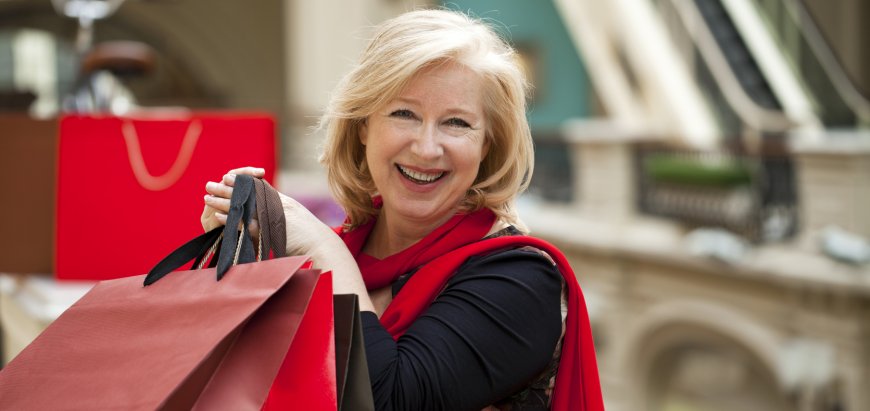
Are Brands Neglecting The Baby Boomers?
We hear a lot about marketing to millennials but new research from global loyalty marketing agency, ICLP found that retailers may be losing touch with the over 55s. 82% of baby boomers said they felt their favourite retail brand just doesn’t understand them and their needs.
Perhaps the age of Snapchat marketing is not only excluding the baby boomer generation but leaving them feeling unimportant and under-appreciated. This is likely to push away a generation who have perhaps been loyal to a brand for some time, and lead them to find an option more tailored to them.
Baby boomers are a generation who have had it pretty good, they were the first generation to go abroad on holiday rather than to fight a war, and many have already comfortably retired on generous pensions. This, of course, means that there’s disposable income there for the spending. Brands within the travel, leisure, health and home improvement industries should most probably count the over 55s as one of their most important target audiences. So according to this research, what can brands do to keep hold, or regain, the loyalty of this important consumer generation?
- Create stronger rewards programmes: 73% said that they would buy more if they were rewarded better by their favourite retailer.
- Communication is also crucial: 60% would buy more if brands communicated with them better, demonstrating the value of retailer communications when it comes to building devoted and profitable relationships with consumers.
- Reliability and honesty are key: 47% of Baby Boomers said that when it comes to retailers, when things go wrong, it’s important that they get a swift apology and solution.
- Offer consistent and reliable products/services: 70% of Baby Boomers said that they would spend more at their favourite retailer if their products were consistent and reliable.
- Build respect and...Continue reading

How Close Are Small Businesses To Going Completely Cashless?
We may be closer than we think to our first ever cashless day according to Wired. Sweden is particularly close with only 20% of transactions made in cash in 2014, and with e-commerce continuing to grow strongly.
Finance Technology is a hot topic right now, not only in terms online sales, but in-store purchases too. It’s now easier than ever to be a market trader and accept cashless payments via various contactless payment devices, so perhaps small business is leading the way?
Speeding Up Service
In the US the popular salad chain Sweetgreen is soon to make the move to cashless with payment only via their app or by card. Sweetgreen co-founder Jonathan Neman told Business Insider “[going cashless] started with an imperative that we’ve always had at Sweetgreen: How do we simplify things?” The company believe going cashless will speed up service by 10% as well as reducing the threat of robbery or theft.
Plastic, Mobile and Apps
India and Canada also have cities where going completely cashless sooner rather than later look likely. Bus companies here in the UK have spoken about plans to roll out cashless systems within the next few years. Going back to the Sweden, The Guardian recently reported that “Swish, a hugely popular app developed jointly with the major banks including Nordea, Handelsbanken, SEB, Danske Bank and Swedbank, uses phone numbers to allow anyone with a smartphone to transfer money from one bank account to another in real time.”
The younger generation has grown up with card and app payments as commonplace so this is only likely to fuel the trend further. MasterCard said contactless spending in the UK had more than tripled in the past year, and The Evening Standard reported that it could be...Continue reading
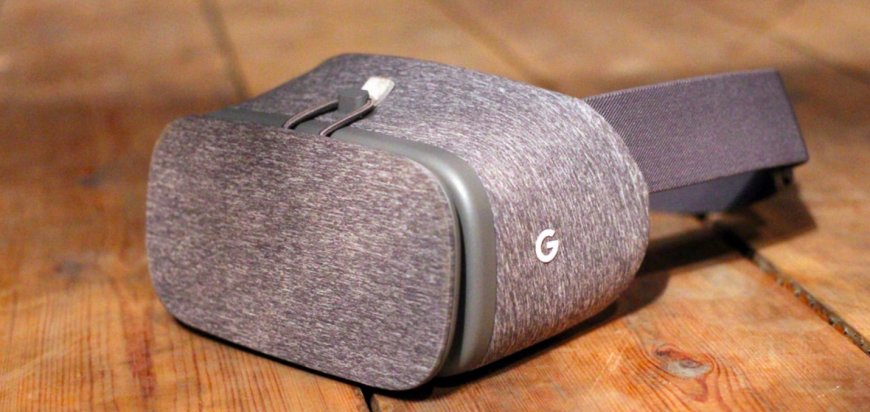
What a Smartphone Needs To Be For Google Daydream Compatibility
Google Daydream is the combination of Google’s new VR headset and virtual experiences. Not locked to specific devices, all you need is a compatible Android phone. The constant development of VR is exciting and there is much discussion and review about how new technology like this could completely change certain industries.
So to begin with, some of the benefits of the Google Daydream (courtesy of a review by Digital Trends) that set the technology apart in a competitive market are;
- Daydream content is high-quality
- Remote has a long battery life and is ergonomic
- Daydream View is comfortable to wear
- Easy to use
- Affordable
So if you fancy getting involved and purchasing a Google Daydream headset (it also comes with remote control) here’s what is required of your smartphone.
Now, the Google Daydream site currently recommends two phones, the Pixel obviously being one, and the Moto Z the second. There are also other Daydream ready phones on the horizon such as the Huawei Mate 9 Pro, the Asus Zenphone AR, and the ZTE Axon 7.
Essentially your phone needs to be able to “handle a pair of 60fps streams and a very low latency and persistence rate. This means the phone can display VR without jittery images, without motion blur that could potentially disorient you” – VRHeads.com.
To handle Daydream a phone needs to have the right combination of specifications. It’s not enough to have some high-spec components and not others. For example, this is why the Huawei Mate 9 is not Daydream compatible but the new Mate 9 Pro will be.
Amit Singh, the VP of Business and Operations for Google VR said; “The combination of performance needs a few things in the stack. The right GPU, Android N and above, and OLED display. There are others,...Continue reading

How Personal Assistants are Changing SEO As We Know It
In a recent video update from Distilled, a leading marketing agency and SEO, we learn about the strong link personal assistants have with SEO. The obvious link is there of course; one use for personal assistants is to ask a question and have them search the web. However, there is way more potential for these apps than simple search alone.
As Distilled explain, the main players in the intelligent personal assistant space include Apple’s Siri, Google Now, Amazon Echo, Microsoft Cortana, along with up-and-coming competitors Hound and Facebook M.

Rather than a search engine simply finding a list of possible answers to your questions, the huge potential for these apps is to anticipate your needs before you even need to ask. The advantage of Google and other big players is data. A certain amount of information can be ‘assumed’ based on demographics such as sex, age, location, occupation etc. but it takes more to really understand an individual (see our blog on retargeting for more on this.) What personal assistants like this are aiming to become is your ‘best friend’ so they truly know what you like and don’t like, what you want and when.
Google already offer advanced and personal search features – such as searching through your own private photos, your emails or appointments, and it’s likely that this will be a key part of personal assistants of the future. Google is known as a search engine, but think about their involvement in the Nest home device and driverless cars and the term ‘personal...Continue reading

Being Sustainable | How Big Brands Are Learning From SMEs
The Charted Institute of Marketing have brought together some really nice examples of how, for big business, learning from SMEs might be very effective advice.
Many creative ideas, viral marketing and innovative campaigns have started life small, and having the ability and flexibility to be truly innovative and creative is often a trait of young and small business. Being nimble, pioneering and sustainable are other characteristics of entrepreneurial small business – and particularly qualities big businesses could do with learning from SMEs.
In the CIM’s special ‘Marketing Sustainability’ report they spoke to three thriving SMEs who have made sustainability one of their key focuses. By being sustainable they have found new marketing opportunities and new business. Here are the three SMEs the report featured.
Wyke Farm
About: Wyke Farm is muti-award winning producer of cheese and butter.
How they’re sustainable: The business is building a renowned reputation for pioneering practices, such as all energy in production coming from solar and biogas. This SME also encourages workers to continually develop sustainable innovations.
What they say: Richard Clothier, managing director said: “A lot of corporates that I speak to, particularly efficient ones that are good at lean manufacturing models, struggle with the concept of sustainability. There is often a myth that it will cost more or complicate the business. But SMEs like ours show that if you develop things incrementally, if you’re authentic and are prepared to invest in a sustainable model, you can grow the business and make it more appealing to customers.”
“The reality is that when you adapt the marketing strategy so that sustainability is at its core, the net positive impact becomes more apparent. It can actually yield savings and efficiencies that you would never achieve using a lean manufacturing strategy alone.”
Falcon Coffees
About: Flacon Coffees...Continue reading

Keep Going with Amazon Go!

Amazon Go is set to launch in Seattle in early 2017 and could be the next step in revolutionising the way we shop in-store.
E-commerce and online shopping is developing almost daily, but our physical, high-street shopping experiences have been becoming more digitalized over the years too. Self-service checkouts, digital catalogues and more recently the introduction of augmented reality for some retail brands is changing the way we shop.
In what could be the next significant move for shoppers Amazon Go is a new kind of shop, that offers a new kind of experience. Walk into the shop and scan your phone (something like entering the tube) put your phone away and simply shop as normal, picking up what you want. The best bit is though, that you can simply walk out, now queuing, no checkouts!
How Does Amazon Go Work?
Amazon describe their ‘Just Walk Out’ technology to be similar to that of self-driving cars, using “computer vision, sensor fusion, and deep learning.” More specific information hasn’t been confirmed but it’s likely that cameras, sensors and artificial intelligence will work together to create the shopping experience of the future. But really as a user all you know need to do is have an Amazon account, which will be charged for what you take from the store shortly after you leave.
The first store in the US will be a grocery store where shoppers can quickly pick up ‘on the go’ snacks or do a bigger shop if they wish.
Amazon Go will of course give Amazon even more customer data about how...Continue reading

Creating a More Sophisticated Retargeting Campaign
Retargeting should now be familiar to most of us as web surfers and consumers. It’s the practice of marketing to people who have already visited your site once. The perceived benefit of this being that you’re marketing to a more targeted audience – people who’ve visited your site before. Well yes, but a very simple campaign like this might not cut it in today’s modern digital world.
It is easy for the wrong people to receive your marketing messages as multiple people may use one device or those who visit a website once may have no interest in ever doing so again, and may never have converted anyway. So this puts into question actually how targeted you can be. These messages can also be annoying for consumers, particularly if they’re not relevant.
So, how can small business owners and marketers make the most of retargeting so as not to pester consumers but also be more relevant and targeted?
Be Cleaver with Data
Consider a more joined-up approach to collecting data and insight about your consumers and their behaviour. Having a central pool of data that comes from multiple sources and all of your channels will allow you to be more specific about who you retarget and why. You’ll no longer be retargeting based on one simple action (such as visiting your site once) but on information and insight that has more depth.
Consider a DMP to help with Retargeting
A Data Managment Platform will allow you combine your customer data and third party data to learn more about your target audience and therefore retarget more effectively and efficiently. A DMP will help minimise the waste retargeting can often cause. For example if an 80 year old lady looks at football boots online it’s likely it’s a mistake or...Continue reading
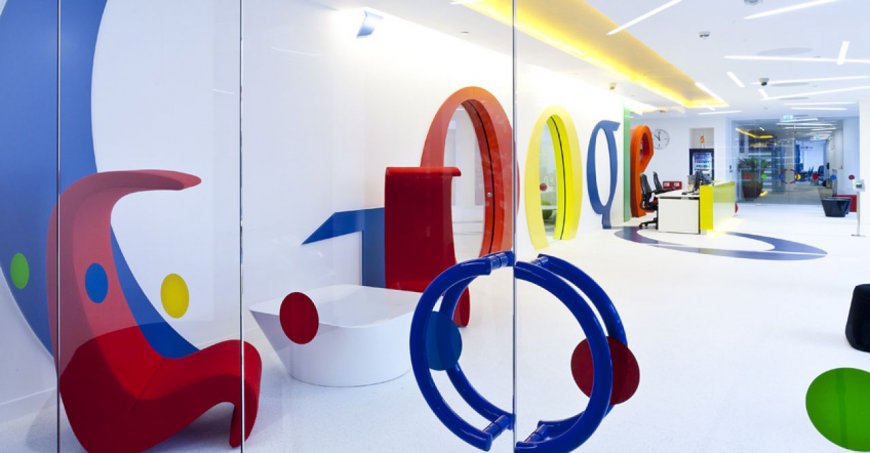
Google plans £1bn UK investment
News of Google’s planned HQ in London – which will create 3,000 new jobs by 2020 – comes as a major boost to Britain’s technology sector.
In his first European broadcast interview since his appointment last year, Google CEO, Sundar Pichai, told the BBC that the UK was still an attractive place to do business, despite Brexit. He named open borders and free movement for “skilled” workers as integral to the success of the UK tech sector.
Sources at Google added that if issues arose around skilled immigration following Brexit, some of the technology’s company’s investment could be at risk, throwing into question whether it would be able to afford the new building.
Google currently employs around 4,000 people in the UK, but that figure could soon rise to 7,000 as the office space they own in Kings Cross will more than double to 65,000 sq-ft.
Mr Pichai made it clear that the strength of the UK economy went beyond the vote to leave the European Union. “We see big opportunities here” the CEO said. “This is a big commitment from us – we have some of the best talent in the world in the UK and to be able to build great products from here sets us up well for the long term.”
“The innovation we see here, the talent we have available here and how on the cutting edge of technology we are able to be here makes it an incredible place for us to invest,” he said.
“We do value how open and connected it is and we can bring in talent from anywhere in the world and we value those attributes and we are optimistic...Continue reading

Consumers Are Willing To Pay More For Purposeful Brands
Michelle Keaney, partnership director at The Marketing Academy and founder of Three Point Zero recently wrote an article for Marketing Week about responsible consumption and how consumers are willing to put their money into ‘purposeful brands.’
As we head into the busiest time of year for most e-commerce brands. Research last year from IRI and Boston Consulting Group showed that the growth of brands classed as Responsible Consumption brands has overtaken ‘conventional’ brands. One of the important points is that RC brands are able to charge a higher price – on average 58% more than regular brands.
For years studies and polls have shown that consumers are keen to shop more responsibly, and it seems now the time has come for them to actively do so. This could be down the fact that there’s more choice when it comes to purposeful brands brands, or that they’re now more accessible than ever.
The opportunity for these brands if big. Globescan’s 2016 public radar shows 40% of ‘aspirational consumers’ – the world’s emerging middle class – want to choose brands that “have a clear purpose and act in the best interests of society.” Although apparently consumers struggle to name brands that represent this purpose they look for, some examples are; Toms shoes, Ella’s Kitchen, Tesla, Cook and Method.

The Risk of Becoming Irrelevant
If responsible consumption is important to 40% of the world’s consumers – could brands that ignore RC become irrelevant? Creating wealth for shareholders is one thing, but there are a progressive amount of social capitalists who believe in addressing challenges and change when it comes to business. However, these two...Continue reading

Boosting Online Sales Over the Festive Period
If you’re an e-commerce business the festive period is likely to be an important time of year for sales as 53% of people plan to shop online. Early preparation and planning will help you make a success of the selling online opportunity, during Black Friday, Christmas, and the post-Christmas sales.
Optimising the Festive Opportunity
Less is More – At this time of year people won’t usually be buying for themselves and are often looking for inspiration. Categorising gifts into sections (for him, for her, for bakers, for gardeners, etc) makes it easy for shoppers to navigate to the right area, where you can then provide them with a concise selection of ideal gifts. This should keep things less complicated for you during a busy period too.
Market to the Millennials – Setting the pace these days for online shopping, this group expect their online shopping experience to be quick, efficient and mobile. Get it right and they could become a key customer group. Even if your products don’t normally appeal to this generation remember this is gift buying time.
Give Last Minute Shoppers an Option – Gift cards are one of the most popular last minute options so make it easy for procrastinators and those who leave things right to the last hour! Delivery will be key to this too – but of course be realistic about what you can offer.
Jump on the Trends – Can you incorporate this year’s hottest trends into your products or promotions? Can you highlight and showcase a selection of product that lend themselves to what’s popular right now? Use social media to generate a buzz!
Branching Out with Your Online Selling
Google Shopping – Google shopping saw huge growth in the first quarter...Continue reading

YouTube Best Practice and Top Tips
For marketers and business owners video is an engaging way to create and share fresh content, and there are more options than ever for doing so. YouTube is currently the third most popular website in the world and has over a billion users. It’s easy to embed YouTube videos across social media platforms, however native video uploaded directly to the likes of Facebook and Twitter seems to be performing better than YouTube video in terms of reach. Choosing to include YouTube into your marketing plan is also about embracing the community and making the most of this channel’s ability to help you get discovered and increase awareness. YouTube should become part of your video strategy, alongside an onsite gallery or the use of video on other social networks.
Why Choose to Use YouTube
- Google search – videos are appearing more in search, so including video on your page could help to improve authority
- The second largest search engine – YouTube is bigger than Bing, Yahoo, Aol and Ask combined with over 3 billion searches a month
- Advertise – there’s lots of effective options for YouTube advertising
- Tell your story – a fantastic way to tell your story online
A Global Audience
YouTube has global audience of 88 different countries and 76 languages. Because so much of the content on YouTube is instructional, it may be that people from all over the world can watch and learn without subtitles. But there is now a wide range of languages available for subtitling too. Video content in the native language to those you’re targeting is always best – if you need to caption, always have a native speaker review for accuracy.
Appeal to How and Where YouTubers Watch Video
Unsurprisingly most YouTubers watch video on mobile, but surprisingly...Continue reading

Why Online Reviews and Testimonials are So Important and How to Make Them Work For...
According to BrightLocal 92% of us read online reviews and 68% consider them a significant trust factor. So as well as building local reputation and trust, reviews can impact your rankings and testimonials can win you in-SERP stars. Many local businesses may also use third-party review sites. But what does all this mean, and what’s the difference?
Third-party reviews are reviews from customers on external sites such as Tripadvisor. Traditional testimonials are snippets taken from a customer and placed direct on your website. The thing is here, you may only choose to display the most positive testimonials on your site. Onsite reviews via website applications now allow business owners to have customer reviews posted directly on their site, often including ratings or stars, or allowing for owners to reply and comment. So there’s lots of options, and Miriam Ellis, local SEO expert at Moz suggests to yield maximum benefits, you’ve got to:
- Know the guidelines and technology
- Have a clear goal and a clear plan for achieving it
- Commit to making a sustained effort
Each site, e.g. Google, Yelp, Facebook, etc. has a different set of guidelines in relation to customer reviews and using schema technology. For more detail about this check out the advice from David Deering on this Moz blog.
In terms of defining your goals for your own on-site consumer feedback pages, you will need to do this per city or area if you have more than one location. Here are Mike Blumenthal’s (GetFiveStars’ co-founder and renowned local SEO) top tips for creating your goals.
Be customer focused – make sure your testimonial page is easily accessible and portrays your brand well.
Be Google focused – get your testimonial page ranking well, ideally showing a star rating. You can also have...Continue reading

A guide to millennial marketing
The millennial market is growing fast. Businesses must be switched on in terms of their marketing tactics to capitalise on the huge buying power of this generation.
A recent study by the University of Southern California showed that there are 87.5 million millennials in the USA alone (ages 18-29). In comparison, 83.7 million people are known as ‘Generation X’ (ages 30-49) and 66.4 million are ‘baby boomers’ (ages 50+).
The study, conducted by the university’s Online Master of Science in Applied Psychology programme looked at the psychology businesses must leverage in order to successfully market to this growing demographic.
The millennial marketing influence lies mainly through the internet and digital devices such as laptops and smartphones, as the below excerpt from USC’s infographic shows. With over a quarter of millennials are highly social and engaged online – in comparison to just 15% of the baby boomer generation – brands that are not prioritising their digital marketing efforts in order to target this generation definitely should.
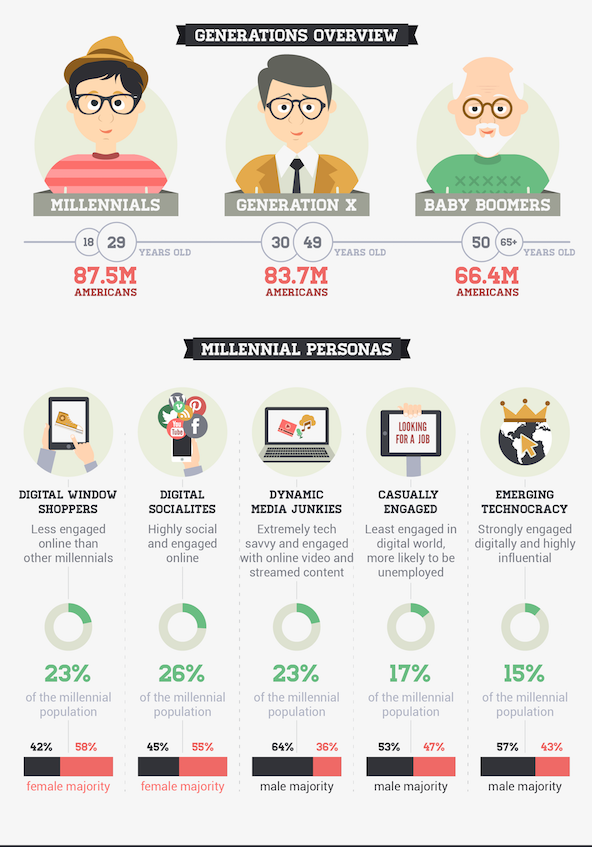
In addition, 85% of millennials own a smartphone and 78% own a laptop and/or computer, showing that its the best way to reach them with marketing campaigns. Millennials also make up the smallest percentage of magazine and newspaper readers and spend the least amount of time watching television or listening to the radio in comparison to other generations.
With almost 90% of millennials using social media, savvy brands are rapidly adapting to take advantage of this opportunity to influence. With 82% of millennials using social media interact with brands or retailers and 38% using it to discover new ones, online brand engagement is reaching an all...Continue reading

A Micro Guide To Micro Influencers
For almost as long as advertising has existed, brands have used celebrities for endorsements. As social media evolves so does the use of influencers for marketing. A study by Nielsen found that only 33% of consumers trust online ads but 90% trust peer recommendations, and with new regulations putting a bigger onus on brands to clearly label when a piece of third-party influencer content has been paid for, micro influencers offer a cost-effective and accessible option for many small businesses.
Shakers and Makers
Time Out published some research recently splitting influencers into the two categories of Shakers and Makers. Shakers being celebrities and very well established and popular social media ‘stars’ and Makers being those with a more modest, but still influential following. The research also found that “makers are 10% more likely to successfully influence somebody else to take an action, despite having fewer followers.”
1,000 Followers Plus
Takumi is a micro influencer marketing platform and suggests that anyone with around 1,000 to 150,000 followers could be considered a micro influencer. Most people have a network of around 500 made up of friends, family and personal connections, but it’s when this network expands beyond this and develops into an ‘audience’ that the potential to influence materialises. You often find that people with slightly smaller networks tend to have more conversations with their audience,” says Solberg Audunsson, the company’s co-founder. “12,000 followers is a good number for you to start to see genuine back-and-forth interactions because people realise they’re more likely to get a response than if they were messaging Kim Kardashian.”
Time and Tools
By their nature of being lower-key than the likes of Zoella, micro influencers can be more difficult to identify. This can make the process of...Continue reading

Account-Based Marketing | Here to Stay?
Growth hacking, micro moments, conversation marketing; all content marketing buzz words that have been buzzing around this year. In fact Contently have put together a list of some of the worst! Is account-based marketing (ABM) a concept that will stick and be adopted by SMEs, or is it likely to be forgotten by 2017?
What is Account-based Marketing?
Often used by B2B firms, account-based marketing brings together sales and marketing focus to a clearly defined set of target accounts. Instead of casting the net wide open and trying to appeal to as my companies as possible ABM is about working in detail on a small number of core clients.
So if you image the traditional sales funnel, built very wide at the top to attract as many prospects as possible and then narrowing to filter through the process. This technique is out with account-based marketing, and instead marketers will cherry pick the brands and organisations that make the most sense to them. Building a relationship and a strategy to work with these organisations means those accounts are getting dedicated time and resource, and also that campaigns and strategies are particularly personalised.
Why Now?
This chart from eMarketer shows that the majority of firms are considering incorporating an account-based marketing approach. The fact is that the idea has been around for years, whether labelled with this title or not. It is the advance in technology that has allowed marketers to identify these core accounts more easily and accurately in recent years.
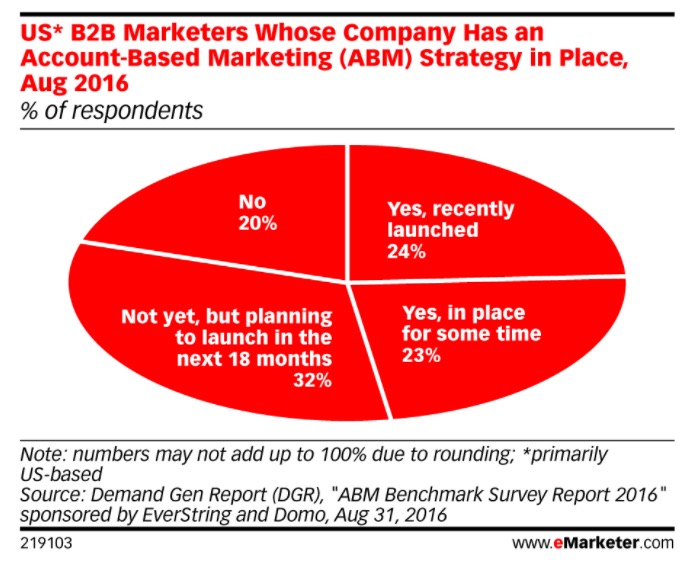
What are the Benefits?
Clear ROI – Marketo point out that compared to other marketing initiatives, the 2014 ITSMA Account-Based Marketing Survey...Continue reading
